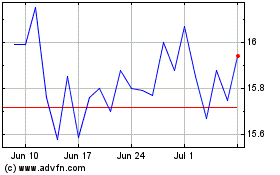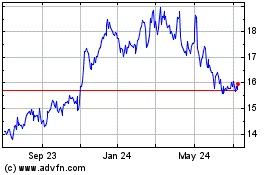Brazil's Oi Seeks Bankruptcy Protection in the U.S.
June 22 2016 - 5:30PM
Dow Jones News
Brazil's Oi SA, a telecommunications company that recently filed
the largest bankruptcy in the country's history, is seeking court
protection in the U.S. to shield its assets from an affiliate of
hedge fund Aurelius Capital Management LP, one of its holdout
bondholders.
Oi and several affiliates sought chapter 15 protection—the
section of the bankruptcy code that deals with international
insolvencies—at the U.S. Bankruptcy Court in Manhattan on Tuesday,
with a debt load of $19 billion. A day earlier, the troubled
telecom firm filed for the equivalent of chapter 11 in Brazil after
an out-of-court restructuring proposal collapsed.
If a judge approves Oi's chapter 15 request, the company would
receive the benefits of U.S. bankruptcy law, which halt lawsuits
and block creditors from seizing assets while it focuses on
restructuring at home. Oi has dollar-denominated bonds and says
many of its contracts and licenses, including those concerning
undersea cables and satellite services, are governed by U.S.
law.
Oi has been battling Capricorn Capital Ltd., the Aurelius
affiliate, which has targeted the telecom giant in lawsuit in the
Netherlands over €2.8 billion ($3.16 billion) in intercompany
loans. Oi says chapter 15 protection will help it fend off any
additional litigation from New York-based Aurelius and who may be
looking to interfere in its restructuring efforts.
A spokesman for Aurelius declined to comment Wednesday.
"The threat of additional adverse actions by creditors and the
need for a centralized forum to facilitate its reorganization
compelled the company to begin preparations for a formal judicial
restructuring," said Ojas N. Shah, whom Oi appointed as its foreign
representative in its U.S. bankruptcy proceedings.
In court papers filed Tuesday, Oi blamed its financial woes on a
"perfect storm of economic strain at the corporate, sector-wide,
and national level." A deep recession in Brazil coupled with
corruption scandals has hurt foreign investment and "generally
crippled the Brazilian capital markets," according to Mr. Shah.
The company says it was caught off-guard by a rapid shift in
demand away from so-called fixed-line telephone service to mobile,
the more profitable segment of the telecommunications sector in
Brazil. And regulations forced it to continue expanding its
services into rural areas even as its revenue fell.
A planned merger with competitor TIM Participaç õ es SA, an arm
of Telecom Italia, also fell apart.
Oi is Brazil's fourth-largest telecom company, with more than 74
million customers and 142,000 employees. The company's debt load
largely stems from two mergers, first with Brasil Telecom in 2010
and later with Portuguese company Portugal Telecom, which
ultimately failed to generate enough business to fund the company's
investment needs.
Bayard Gontijo, Oi's chief executive, resigned June 10 under
pressure from shareholders shaken by a debt-for-equity swap
proposed by the company's creditors. The deal would have
significantly diluted the company's shares, giving a 95% stake of
the restructured business to its bondholders.
The negotiations involved Oi's main shareholder, Bratel BV,
which controls a 22.24% stake in the company. Bratel is an
investment vehicle formed by former shareholders of Portugal
Telecom, using the official name Pharol SGPS. On the other side of
the table, investment bank Moelis & Co. is advising creditors
with around 40% of outstanding bonds, including big international
players such as Pacific Investment Management Co., Citadel LLC and
Wellington Management Co.
Rogerio Jelmayer and Luciana Magalhaes contributed to this
article.
Write to Tom Corrigan at tom.corrigan@wsj.com
(END) Dow Jones Newswires
June 22, 2016 17:15 ET (21:15 GMT)
Copyright (c) 2016 Dow Jones & Company, Inc.
TIM ON (BOV:TIMS3)
Historical Stock Chart
From Mar 2024 to Apr 2024

TIM ON (BOV:TIMS3)
Historical Stock Chart
From Apr 2023 to Apr 2024
